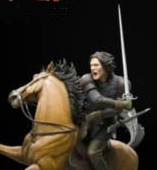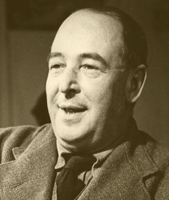Prince Caspian: Our Inner Child Finds A New Hero

"Prince Caspian," the sequel to the 2005 Disney hit, "The Lion, the Witch and the Wardrobe," does not pick up the story where its predecessor left off, in Narnia's exhilarating Golden Age, but in a time of fear and despair. From this deep dip on the cinematic roller-coaster, it offers to lift us to the heavens, with many a rise and fall and a twisty turn between. In its masterful blend of fast pacing, exciting action, dazzling special effects, and thrilling musical score, "Prince Caspian" does not disappoint.
Back to the Narnian Beach
With the next school term looming ahead, the Pevensie children, Peter, Susan, Edmund and Lucy, wait gloomily at a railway station in 1941 England. Suddenly, they feel something like a sharp sting at their backs and the next instant find themselves on a seaside beach bordered by a thick forest. Could they be... back in Narnia?
Soon they discover that they have indeed returned to Cair Paravel, the castle where they had reigned as kings and queens. Now, however, it is in ruins and overgrown, as if a thousand years have passed. Yet the Pevensies have only been away from Narnia for a year by our calendar.
A dwarf named Trumpkin, whom they rescue from two would-be executors, tells them the bitter truth: Cruel Miraz the Telmarine now rules Narnia. Having seized the throne by murdering his own brother, King Caspian IX, Miraz now wants to slay his nephew, Prince Caspian, the true king. The Pevensies are dismayed to learn that the Telmarines have driven all of the Talking Beasts into hiding and that even the trees have fallen into a deep sleep.
Trumpkin tells them that Caspian seeks to reclaim the throne with the help of the Talking Beasts, the dwarves, and a few giants. Though noble and courageous, his soldiers are no match for Miraz's troops. After a particularly bloody battle, Caspian has just turned to his last resort. He would blow Queen Susan's magic horn, hoping it would summon help from an unexpected quarter, as its legend promised. Caspian, in fact, had sent Trumpkin ahead to Cair Paravel, not to be captured by sentries at a Telmarine outpost, but to serve as guide, in case the horn should summon the Pevensies, or even Aslan the Lion, legendary ruler of all Narnia.
Now the two "sons of Adam" and the two "daughters of Eve" understand how and why they got back into Narnia. Once they know how desperately Caspian and the "Old Narnians" need them, they willingly begin their difficult journey to join the prince in his war against Miraz. The story reaches its climax as its characters are forced to ask and answer vital questions like, "Whom can we trust and why?" and "Does achieving a high and noble goal justify using a desperately wicked means?"
Lewis's Original Series
Prince Caspian is actually volume four of The Chronicles of Narnia, the seven-book series by C. S. Lewis (1898 - 1963). Lewis was a professor of Medieval literature at Oxford and later at Cambridge who wrote many books on Christian apologetics as well as novels with Christian themes. He was enamored with the classical Graeco-Roman mythology as well as the chivalry of medieval knights.
In Chronicles he crafted a world peopled with such creatures as fauns, centaurs, and dryads. Then he asked himself, "How do you suppose the Christ would represent Himself in such a world?" How else but as Aslan, the giant lion who is awesome and powerful, gentle yet frightening, nearby yet hidden, and not at all tame? This scheme of "supposal," as he called it, explains the Christian symbolism in The Chronicles in a more satisfactory way than regarding it as a this-for-that Christian allegory.
Lessons for the Teachable
The main messages of "Prince Caspian" are these:
- You cannot determine who is right and who isn't by merely taking a head-count. True heroes must often struggle as a few against a numberless multitude.
- Every individual in such a struggle has latent resources--his or her own unique talents, skills, and abilities--to lend to the cause, and each one of them, no matter how short, stupid, or feeble, can make a valuable contribution.
- The fight for the right is a team effort, demanding that we set aside all of our differences and pull together.
- Winning is not everything. How you win is just as important, or more so, for it reveals the wisdom of your choices, your strength of your loyalties, and the worth of your comrades.
Minor Themes Include:
- Ecology - the Telmarines are afraid of the forest, they have hacked and chopped away until the trees hate them bitterly.
- Racism - The Telmarines hate everyone that does not belong to their homogeneous race. The dwarfs have suffered at the hands of other races so that now they find it hard to trust anyone, including all who are only half-dwarf. Those of "old Narnia" accept each other despite their diversity of races and species.
- Sexism - the two girls are as vital to the outcome as the boys, perhaps more so.
If you are willing to set aside your cynicism, willing to immerse yourself in an awesome world with formidable foes and surprising allies, this movie is yours to enjoy, not just as a viewer, but as a participating hero.
Movie Facts
2 hrs. 24 min., rated PG. Andrew Adamson directed the film and co-wrote the screenplay with Chistopher Markus and Stephen McFeely. Cast: Ben Barnes stars as Prince Caspian. The Pevensies all reprise their roles in "The Lion, the Witch and the Wardrobe": William Moseley as Peter, Anna Popplewell as Susan, Skandar Keynes as Edmund, and Georgie Henley as Lucy. Peter Dinklage plays Trumpkin and Sergio Castellitto, Miraz. Liam Neeson supplies the voice of Aslan. Original music is by Harry Gregson-Williams, with cinematography by Karl Walter Lindenlaub. The castles and forests of the Czech Republic near Prague prove a serviceable Narnia. Disney has already announced the next installment of the "Chronicles of Narnia" franchise, "The Voyage of the Dawn Treader," scheduled for release on May 7, 2010.
--Steve Singleton
DeeperStudy.com
Want to go deeper?
One of the main issues with which "Prince Caspian" wrestles is whether the use of despicable means is legitimate for accomplishing a worthy goal. This issue is relevant to our current situation, as U.S. citizens debate the legitimacy of the Guantanamo prison and the use of waterboarding and other tortures to extract information from suspected terrorists. Here are some biblical passages that grapple with the same issue:
- Goal: To get the son of promise. Means: Taking Hagar as a wife – Genesis 16:1 - 17:22
- Goal: To provide water for Israelites. Means: Striking rock and not giving God the glory – Numbers 20:1-12
- Goal: To keep troops from scattering. Means: Offering sacrifice instead of waiting for Samuel to do it – 1 Samuel 13:7-14
- Goal: Making treaties with other nations. Means (apparently): Marry foreign wives – 1 Kings 11:1-13
- Goal (one suggestion): To get Jesus to proclaim Himself king. Means: Get him arrested – Matthew 26:14-16, 47-56; 27:1-10
For purchase:
 "Prince Caspian" audiobook (unabridged on CD - 4 hrs. on 4 CDs)
"Prince Caspian" audiobook (unabridged on CD - 4 hrs. on 4 CDs)- The Chronicles of Narnia (boxed set of 7 vols.)
- - Full-color collector's edition
- - Slip-cased, soft cover set
- - Deluxe edition set
- - One-volume edition (with Prince Caspian on cover)
You might want to use the "Prince Caspian" movie as an opportunity to discuss Christian Ethics with young viewers. Here are some recommended resources:
- Sean Covey. The Six Most Important Decisions You'll Ever Make: A Guide for Teens (2006) for teens
- Kenneth Taylor. Right and Wrong for Kids. (1999) for ages 4-7
Adults should take a look at:
- Craig V. Mitchell. Charts of Christian Ethics (2006) 100+ charts
- Roger H. Cook. An Introduction to Christian Ethics, 5th ed. (2006) 320 pp.
- James Childress & John Macquarrie, eds. Westminster Dictionary of Christian Ethics (1986) 700 pp.
Labels: christian ethics, chronicles of narnia, narnia, prince caspian
6/04/2008the makers of Prince Caspian kept to the original story better than i would have expected... i had heard they were going to make it into a silly pure-action flick, but thankfully this was not so much the case
» Post a Comment